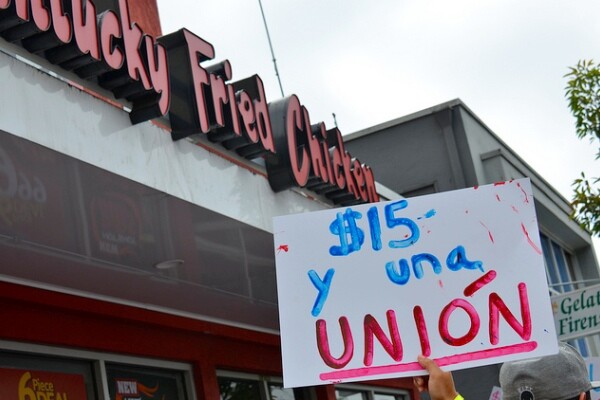Is This The Start of a Fast Food Union?

When the fast food worker strikes started up last November, the basic demand relayed by the media was that the workers wanted to make $15 an hour. It makes sense why that amount would stick in people's minds, but there was another important issue the workers were striking for: the right to form a union.
While the first goal is seemingly out of reach until the federally-mandated minimum wage bumps up a bit, the latter goal may have gotten some legs over the weekend in Chicago.
In an expo center in the westside suburbs, over 1,200 people from around the country spent two days shaking hands, trading business cards, and listening to rallying cries and instructional speeches at the first ever labor convention for fast food workers.
The keynote address was given by Mary Kay Henry, the president of the Service Employees International Union. (The S.E.I.U., with over two million members, is the second largest union in the country.) And she wasn't pulling any punches:
"A selfish few at the top are using their power to hold down wages, no matter how much that hurts families and communities across the country."
The enthusiasm at the rally, as well as simply the numbers present, give off the impression that this event wasn't just some one-time thing. Instead, maybe it was the birth of a union.
The efforts to form a fast food workers union have long been thwarted for a variety of reasons. Trying to organize that massive a number of people (over 3.5 million workers in 2013) who work for hundreds of different companies is a logistical challenge. But a bigger hurdle is the emotional component of trying to get workers to take on the people who are signing their paychecks. Most workers feel as though they can be fired at any time for showing resistance to their company:
"When I first heard about it, I'm not gonna lie, I was kind of skeptical. I was thinking, 'I'm gonna lose my job, I'm gonna get in trouble,'" Douglesha Nicholson, a 23-year-old Pizza Hut worker from Kansas City, told VICE News. But after the first strike, she was sold.
This rally, then, was a way to spread information about how to go about organizing, as well as showing the strength of solidarity. And on the Tuesday following the rally, the ability to form a union got another huge boost.
The National Labor Relations Board ruled that McDonald's could be found liable for labor and wage violations after they were found guilty for firing and threatening workers involved in "pro-labor activities." Due to that ruling, McDonald's will be deemed a "joint employer," despite the fact that 90 perfect of its businesses are technically franchise operations. It's complex legalese, but essentially it means that if McDonald's is deemed a joint employer, employees of that company can more freely band together and unionize without fear of repurcussions:
Some legal experts described it as a far-reaching move that could signal the labor board's willingness to hold many other companies to the same standard of "joint employer," making businesses that use subcontractors or temp agencies at least partly liable in cases of overtime, wage or union-organizing violations.
And as goes McDonald's, so goes the rest of the industry.
Now, the ruling still has quite a ways to go before becoming official, as McDonald's has vowed to take if all the way up the ladder to the Supreme Court. (The Golden Arches has a long history of fighting tooth-and-nail against unionizing.) But if the ruling sticks, this could be the week that plants the seeds of the country's first fast food labor union.


